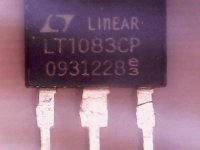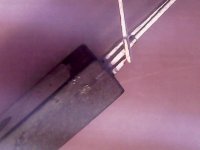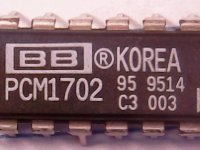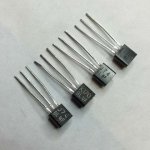....................I don't know of any manufacturer who doesn't destroy off-spec parts............... Most off-spec products are discarded from the line into protected containers and have security all the way to destruction...................
Things have changed a lot!!!
In the mid-60s, I would buy 'reject' SCRs (Mullard) and also transistors openly in a shop in south Manchester. Nothing wrong with them except badly welded solder tags or mis-shaped leads.
However, I knew that I was buying rejects.
Don't forget that Sir Clive Sinclair made his fortune on buying and retesting reject for use in his designs.
(also the 486sx chips were reject 486DX )
Andy
Thanks for the post and pictures, Jitter. I took a closer look at the leads of the fake LT1083's and attached some pics. The first shows the welds, the second where the lead snapped at the weld when I very gently bent it. And the e3 marking after the date code is different than you show and any that I have seen on legit parts.
The last pic is a PCM1702 off eBay. I haven't been able to spot any discrepancies on the markings.
Phil
The last pic is a PCM1702 off eBay. I haven't been able to spot any discrepancies on the markings.
Phil
Attachments
Hi jitter,
That is fascinating! I have to ask. Is it cheaper to obtain pulls, clean them up and reattach leads to them than it is to simply sell the real deal that is new? I can't believe there is money in this.
Thank you very much for posting the x-ray of those two parts. It's interesting stuff.
-Chris
Apparently, there is money in counterfeiting them.
New LT1083, LT1084 or LT1085 in TO-3 or TO-3P packages are unavailable from authorized suppliers, they are long past the "last time buy" date.
New genuine LT1083/1084/1085 are still available in TO-220 package, but I was surprised to find that Digikey wants USD 8.20 for one LT1084CT-5 or USD 4.54/piece when bought per 1000.
The only companies still stocking the LT1084CP-5 (the TO-3P we need) are unknown, broker-type suppliers; Arrow, Avnet, Digikey and so on don't have them anymore.
I did the acetone test on the genuine and counterfeit items and here are the results:
Before:

After:

It was not easy to rub off the printing of the counterfeit, but as you can see, it did eventually start to lift. The genuine item also suffered from the rubbing with acetone somewhat, but not nearly as much.
Look closer and you'll see that the font is also slightly different, most prominently visible in the "C" and the "5". The company logo is actually nicer on the counterfeit/refurbished part (look at the "A").
The fact that the plastic of the counterfeit/refurbished item smoothed quite a bit from the rubbing with acetone has me wonder if these are actually salvaged components.
Note that the roundels in the genuine item have "THAILAND" in the left and "B77" in the right and that the counterfeit has no text there. But that is only the case with this particular one, other counterfeits do have text in them, but they vary.
As an aside:
We do see counterfeits from time to time that brokers sell as "surplus stock acquired from electronics manufacturers". More often than not, they turn out to be salvaged components that were sanded down or sand blasted and laser etched with new markings. They can look like new items, but sometimes, they take it too far as this picture shows:

The bonding wires became exposed...
Last edited:
Thanks for the post and pictures, Jitter. I took a closer look at the leads of the fake LT1083's and attached some pics. The first shows the welds, the second where the lead snapped at the weld when I very gently bent it. And the e3 marking after the date code is different than you show and any that I have seen on legit parts.
The last pic is a PCM1702 off eBay. I haven't been able to spot any discrepancies on the markings.
Phil
Wow, those are really poorly counterfeited parts. At least the ones we got looked a whole lot better and only a minor percentage failed. 1% or so, but that was 1% more than the genuine items. We used thousands of these regulators over the years, and we never had a single failure with the genuine ones.
Getting BB components with a datecode of 1995 probably means they're fake as well.
Last edited:
Hi sbrook,
I don't know of any manufacturer who doesn't destroy off-spec parts. They can be subject to theft, but that is a criminal matter. A reputation to a foundry and fab is so important that they will not risk mislabeling defective product. Most off-spec products are discarded from the line into protected containers and have security all the way to destruction. It's a big problem and they do not want to end up on the list of non-compliant manufacturers. That'll shut down a foundry quick as can be.
-Chris
We bought a couple of reels of Macom microwave switches that we used in a product at work a few years ago. There were issues with availability and lead time at the time with Macom, but we found a reel from a reseller we usually don’t use.
The switches worked initially, but the in-service failure rate was stupendous, with about a ten percent failure rate over six months. We went back to Macom and had a huge whinge. We had all the doco plus the reels with remaining parts and labels.
Turns out they were a batch that had failed QA at Macom and found their way out the back door. It was a huge problem for us, involving rework of hundreds of boards to replace the switches. A few of us (including me) got really good at DFN package rework from that. I still have a little beaker full of dead switches on my bench as a momento.
You’d think we’d have learned from that, but we haven’t. We still design equipment with obsolete or single-source parts with long lead times, and still go to the shady vendors when we’re up against deadlines and haven’t got the parts.
I was shocked at the cost of the LT1084 on Digit-Key also and bought LM1084 instead. I didn't compare specs as I'm just using them for filament regs in a tube phono preamp (kevinkr's Muscovite).
I glanced over the datasheets, and it looks like they should be pretty much identical in performance. Why then the LT1084 should cost more than triple what the Texas Instruments' version costs is beyond me. Surely there's more to it than just production volumes?
Just goes to show that it’s not just hobbyists that get stung. This was a >$10K order by an organisation that should know better.
Right. The company I work for has made comparable silly choices. Sometimes forced by availability, sometimes because of price. That Xilinx Spartan from a few posts back? Yep, that is a good example. They were bought because of a lower price, and boy did that turn out to be more expensive in the long run.
Buying off eBay and aliexpress and the likes is asking for fakes. Hobbyists too can get the real parts from companies like Digikey, but they should be willing to pay the price that goes with them.
If something seems too good to be true, it usually is.
Feedback on 2SJ74/2SK170 pls
Hey all, I just bought these jfets from a vendor and I have some suspicion that one pair may be counterfeits.
The upper pair in the attached picture looks like others that I have bought before - lettering appears etched in, and the "one" in 170 looks like "l".
The bottom pair have clearly been painted on (and badly at that).
IDSS measures okay for BL pairs (about 9.35mA for these pairs).
I tried looking for a schematic of a jig that would allow other measurements (pinch-off, etc) but found that some links in this thread redirect to bad places.
Hope that I can get some feedback on this before I go back to the vendor.
Thanks,
-Keith-
Hey all, I just bought these jfets from a vendor and I have some suspicion that one pair may be counterfeits.

The upper pair in the attached picture looks like others that I have bought before - lettering appears etched in, and the "one" in 170 looks like "l".
The bottom pair have clearly been painted on (and badly at that).
IDSS measures okay for BL pairs (about 9.35mA for these pairs).
I tried looking for a schematic of a jig that would allow other measurements (pinch-off, etc) but found that some links in this thread redirect to bad places.
Hope that I can get some feedback on this before I go back to the vendor.
Thanks,
-Keith-
Attachments
Thanks
Walter, thank you!
Thank too for the link to EUVL's paper - I will do some tests to see just what we have here.
-Keith-
Walter, thank you!
Yes, the mixed pairs were puzzling to me as well, especially that these are from a well-known vendor in these forums.A bit strange that one vendor sells a good pair together with a bad pair.
Thank too for the link to EUVL's paper - I will do some tests to see just what we have here.

-Keith-
Why you don't say his name?Walter, thank you!
Yes, the mixed pairs were puzzling to me as well, especially that these are from a well-known vendor in these forums.
Thank too for the link to EUVL's paper - I will do some tests to see just what we have here.
-Keith-
Hey Thimios, a natural linkage to be sure. For now, it is because the vendor should be made aware and given opportunity to respond.Why you don't say his name?
-Keith-
That bottom pair is definitely fake. The upper pair looks OK. A bit strange that one vendor sells a good pair together with a bad pair.
They sell me only bad pairs
I'm the vendor.
These FETs are perfectly genuine - all four of them.
You should know better than judging fakes by the type of marking.
Several different types of labelling were used by Toshiba over the years.
I will send you a pair of the "definitely fake" ones, if you promise to promptly post your finding here.
All my Jfets have been curve traced so I have nothing to fear.
Cheers,
Nic
- Home
- Design & Build
- Parts
- My Transistors, original or copy?



